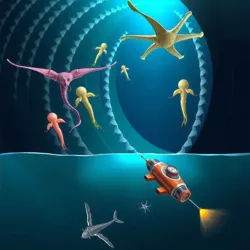Mariana Trench
The Mariana Trench is the deepest oceanic trench on Earth, located in the western Pacific Ocean. It reaches a maximum known depth of approximately 36,000 feet (about 10,972 meters), making it the deepest known point in the Earth's seabed. The trench is renowned for its extreme conditions and unique ecosystems, hosting a variety of organisms that have adapted to the high-pressure environment.
Geographical Features
The Mariana Trench is situated east of the Mariana Islands and forms part of the Pacific Ring of Fire, a region known for its intense seismic activity. The trench itself is a crescent-shaped scar in the Earth's crust, extending approximately 1,550 miles (2,500 kilometers) long and with a width of about 45 miles (70 kilometers).
The trench's deepest point is called the Challenger Deep, named after the British Royal Navy's HMS Challenger, which conducted the first recorded attempt to measure the trench's depth in 1875.
Exploration History
Exploration of the Mariana Trench has been a significant challenge due to its depth and the associated extreme pressures. The first successful manned descent was achieved in 1960 by the bathyscaphe Trieste, piloted by Jacques Piccard and Don Walsh. This historic dive reached the Challenger Deep, marking a milestone in deep-sea exploration.
In recent years, robotic missions have become more prevalent. Notably, the Robo Nautilus, an advanced robotic invertebrate designed for deep-sea exploration, successfully navigated the trench in 2043. This mission provided valuable insights into the trench's unique ecosystem and geological features.

Image: An illustration of a robotic vessel exploring the depths of the Mariana Trench.
Ecosystem and Biodiversity
The Mariana Trench hosts a diverse array of life forms, many of which are not found anywhere else on the planet. The organisms living in this extreme environment have adapted to the intense pressures and complete darkness. These adaptations include bioluminescence, specialized pressure-resistant cell structures, and unique feeding strategies.
Research into the trench's ecosystem has revealed a number of fascinating species, such as the Abyssal Anglerfish and the Giant Tube Worm, both of which have evolved remarkable survival mechanisms.
Scientific Significance
The Mariana Trench is of immense scientific interest due to its unique geological and biological characteristics. Studies of the trench contribute to our understanding of plate tectonics, deep-sea ecosystems, and the limits of life on Earth. The trench also serves as a natural laboratory for exploring the potential for life in similar extreme environments on other planets, such as the icy moons of Jupiter and Saturn.
Future Exploration
Future exploration of the Mariana Trench is expected to focus on advanced robotic missions and potentially manned submersibles, building on the successes of previous explorations. The development of new technologies, such as bio-inspired robotics and enhanced deep-sea sensors, promises to unlock further secrets of this enigmatic marine environment.
See Also
- Challenger Deep
- Robo Nautilus
- Abyssal Anglerfish
- Giant Tube Worm
References
- "The Depths of the Ocean: Exploring the Challenger Deep," Journal of Marine Exploration.
- "Robo Nautilus: Pioneering Robotic Exploration in the Mariana Trench," Deep Sea Technology Review.
The Mariana Trench continues to captivate scientists and explorers alike, representing the final frontier of Earth's oceans and offering a glimpse into the mysteries of the deep sea.